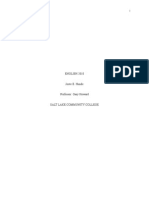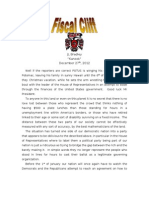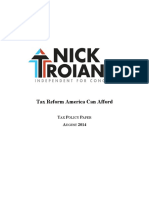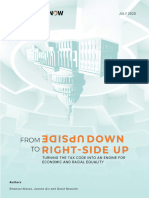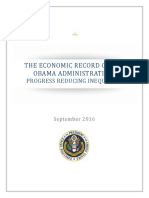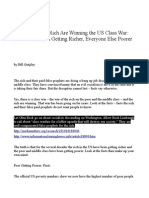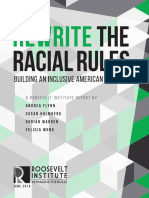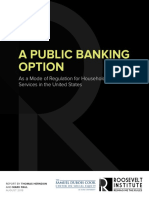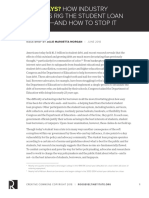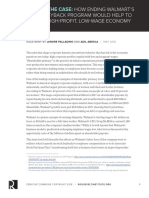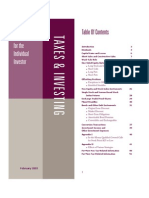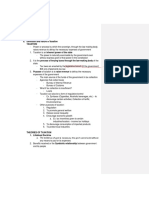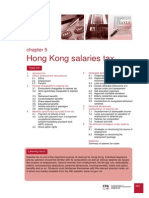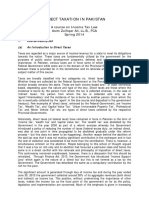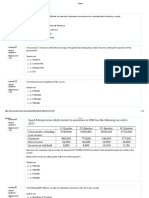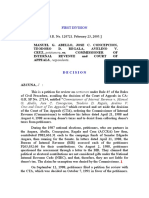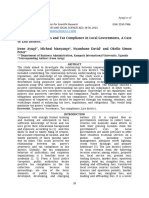Hidden Rules of Race Are Embedded in The New Tax Law
Uploaded by
Roosevelt InstituteHidden Rules of Race Are Embedded in The New Tax Law
Uploaded by
Roosevelt InstituteHIDDEN RULES OF RACE ARE EMBEDDED
IN THE NEW TAX LAW
ISSUE BRIEF BY DARRICK HAMILTON AND MICHAEL LINDEN | MAY 2018
The federal tax code is one of the most powerful tools of economic policymaking. It can
incentivize, subsidize, or discourage certain behaviors or activities. It can impose economic
burdens, or it can relieve them. It can shift resources from one area to another. It can provide
an implicit check on the outsized power, including political power, that is accrued by one class
of people with a gross disproportion of societal resources, or it can reinforce and amplify that
power. The federal tax code, in other words, houses some of most critical rules that govern
our economy. As such, it is also home to a set of hidden racial rules that, through intention or
neglect, provide opportunities to some communities and create barriers for others.
The hidden rules of race (Flynn et al. 2017) are the racial rules that reshape the economy,
and society more broadly, for black and brown Americans. These rules—historic and
current, implicit and explicit—have driven disparities ranging from wealth creation and
educational attainment to health care access and economic mobility.
The recently enacted Tax Cuts and Jobs Act, known colloquially as the Trump tax law, was
a substantial rewrite of the tax code. Far from addressing, fixing, or improving the hidden
rules of the tax code that disadvantage people of color, the new law strengthened some of
these rules and even added new ones. The sum total effect of the Trump tax law is likely
to further increase the economic disparities, particularly with regards to wealth, between
white Americans and communities of color.
There are at least four major ways in which the new tax law will have a disparate negative
impact on people of color. First, the tax law’s benefits accrue disproportionately to high-
income households, which means that, because of the long-established racial income gaps,
white households will capture more than their fair share of the tax cuts.
Second, the new law primarily benefits people who hold existing wealth—in everything
from corporate shares to housing stock—rather than providing benefits to create
wealth. Compared to income disparities, racial wealth disparities are more severe and
generationally established, and thus they have a much more intense and lasting impact
that the tax law will exacerbate.
CR E AT IV E C O M M O N S C O PY R IG HT 2 0 1 8 | R O O S EVELTIN S TITU TE. O R G 1
Third, the new law is likely to increase local fees and fines that disproportionately strip
wealth from people of color. By limiting the state and local tax deduction, the law will
push states and localities to rely more on fees and fines as sources of revenue. Not only
are fees and fines more regressive sources of income, but they also extend the reach of a
broken criminal justice system that causes enormous economic and civic damage within
communities of color.
Finally, the enormous revenue loss caused by this law, coupled with the limitation on the state
and local tax deduction, will undermine the public sector. This will be particularly true at the
state and local levels where governments are often constrained to balance their budgets. At
the federal level, the woeful irony of a budget-busting tax cut skewed towards the wealthy in a
political context that overemphasizes austerity will likely mean an acceleration of the already
dimensioned public sector labor force. Black workers make up a disproportionate share of
public employees, and public employment plays a disproportionately important role in black
communities. Cuts to public employment will therefore impose a disparate burden on black
American workers and black American communities.
In sum, the Tax Cuts and Jobs Act enhances existing hidden rules and creates new ones
that negatively impact people of color. The scale of the long-term impacts of these rules is
yet to be determined, but the direction of that impact is clear: In addition to disadvantaging
low- and middle-income people in favor of the rich and powerful few, the Trump tax law
specifically preys upon people of color.
THE NEW TAX LAW IS SKEWED IN FAVOR OF
HIGH-INCOME HOUSEHOLDS, DISADVANTAGING
BLACK AND BROWN FAMILIES
The Tax Cuts and Jobs Act disproportionately benefits individuals and households at
the high end of the income spectrum. The central elements of the new law—a large rate
reduction for corporations, a new tax deduction for “qualified business income,” lower
personal income tax rates, a reduction in the Alternative Minimum Tax, and a large cut to
the estate tax—all mainly benefit richer people. The result of these changes is very large tax
cut for those at the top, compared to a modest tax cut for those in the middle, and almost no
tax cut at all for those at the bottom.
According to the Tax Policy Center, for 2018, the average tax cut for the richest 1 percent is
roughly 50 times larger, in raw dollars, than the average tax cut for someone in the middle
quintile, and it’s 850 times larger than the average tax cut for someone in the bottom
quintile. Even as a share of income, the law’s benefits skew toward those with high incomes.
CR E AT IV E C O M M O N S C O PY R IG HT 2 0 1 8 | R O O S EVELTIN S TITU TE. O R G 2
The average household in the top 5 percent of income earners can expect to see their
incomes rise by roughly 4 percent, which is twice the increase for someone in the middle
quintile and about 10 times more than someone in the bottom quintile (Tax Policy Center
2018a). Moreover, households in the bottom quintile are significantly more likely to receive
no tax cut at all compared to those at the top. Over 95 percent of all households in the top 5
percent will receive a tax cut, compared to only 53 percent of those in the bottom quintile
(Tax Policy Center 2018b).
The law also becomes more skewed toward the rich over time, as certain provisions expire.
By 2027, fully 83 percent of the tax cuts flow to those in the top 1 percent, while those in the
bottom 60 percent will, on average, actually experience tax increases relative to the previous
tax law (Tax Policy Center 2017).
The overall skew of the Trump tax law toward the rich is both well-covered by the media
and well-known by the public. In a recent Quinnipiac University poll (2018), fully 62 percent
of respondents agreed that the law mainly benefits the wealthy rather than the middle class.
What is less well understood is the racial implications of this income skew.
The richest Americans are the disproportionate beneficiaries of the Trump tax law,
and the richest Americans are also disproportionately white. According to the Current
Population Survey (2016), while white households make up 67 percent of all households in
the country, they constitute 78 percent of those in the richest 5 percent of income earners.
Black households, on the other hand, make up 13 percent of all households but comprise
just 5 percent of those in the top 5 percent. Similarly, Hispanic households are 13 percent
of the total, but they account for just 6 percent of those in the top. On the other end of the
income spectrum, both black households and Hispanic households are overrepresented in
the bottom income quintile (United States Census Bureau 2016). Consequently, by cutting
taxes for the rich, while mainly leaving out the poorest Americans from the tax changes
entirely, the Trump tax law also very directly delivers disproportionate tax benefits to white
Americans relative to Americans of color.
WEALTH IS EVEN MORE RACIALLY STRATIFIED THAN
INCOME, AND THE NEW TAX LAW BENEFITS THOSE WITH
EXISTING WEALTH
Compared to income, wealth is far more concentrated in the hands of a few, and the racial
implications are even more lasting and damaging. Unfortunately, as with income, the new
Trump tax law favors those with existing wealth over those who are striving to create new
wealth and in so doing reinforces the destructive racial rules of wealth.
CR E AT IV E C O M M O N S C O PY R IG HT 2 0 1 8 | R O O S EVELTIN S TITU TE. O R G 3
The richest 1 percent of Americans take home about 20 percent of all the income, but own
about 40 percent of all the wealth (Saez and Zucman 2015). Moreover, the racial gaps in
wealth are even starker than the income gaps. The median income for white households
is roughly 65 percent higher than it is for black households (Pew Research Center 2016).
Meanwhile, median net worth among white households is about 1200 percent larger
than it is among black households (Pew Research Center 2016). Twenty percent of black
families have no wealth at all, compared to only 9 percent of white families (Dettling 2017).
Virtually all of the economic gains from the last four decades have accrued to households
in the top 20 percent of the income distribution, a group that is overwhelmingly and
disproportionately white (Hamilton and Famighetti 2017). This racial wealth inequality
persists even after accounting for educational attainment. White families with a head of
household who dropped out of high school have more wealth than black families with a head
of household who finished college (Hamilton et al. 2015; Darity et al. 2018).
Wealth inequality—far more than income inequality—has a persistent negative effect on
economic opportunity, mobility, and security. Households with wealth pass enormous
economic advantages on to future generations that those without wealth can rarely, if ever,
match. A child born into a family with wealth can often expect to enjoy debt-free higher
education, help purchasing his or her first home, seed financing for starting a business,
and the general comfort that comes from knowing there is a strong safety net to fall back
on. Children without wealth benefit from none of these advantages. In fact, rather than
receiving economic resources, adult children of parents without wealth are often called
upon to provide resources for financially less well-off kin. Unlike income, wealth can be
transferred directly from one generation to the next, cementing economic advantages—and
disadvantages—across decades and even centuries.
The racial wealth gap is rooted in the history of chattel slavery, when black people
themselves were considered capital assets that fueled the wealth of a white plantation
owning class, which served as the impetus for modern financial capital markets (Baptist
2014). Since the abolition of slavery, public policies have mainly served to perpetuate the
racial wealth gap. From redlining to mass incarceration to unregulated predatory lending,
federal, state, and local policies have tended to erect barriers to wealth creation for black
and brown people, while protecting and expanding the legacy of wealth that exists mainly in
the accounts of white people.
The Tax Cuts and Jobs Act continues in that trend, favoring existing wealth over new wealth
creation in numerous important ways. For example, one of the centerpieces of the new
law is its massive tax cut for corporations, reducing their tax rate down from 35 percent
to 21 percent. That one change alone is worth about $1.3 trillion over the next decade
(Joint Committee on Taxation 2017). Tax cuts for corporations disproportionately benefit
CR E AT IV E C O M M O N S C O PY R IG HT 2 0 1 8 | R O O S EVELTIN S TITU TE. O R G 4
existing shareholders rather than workers or consumers. Despite baseless promises that the
corporate tax cuts would translate into $4,000 wage increases, nearly all nonpartisan and
official estimates suggest that even over the long run, roughly three-quarters of the benefits
from Trump’s corporate tax cuts flow to the owners of the corporations (Center on Budget
and Policy Priorities 2017). Further, there is scant evidence that the presumed promise of
“trickle-down” job creation from increased firm investment has ever been realized. What
is clear is growing economic disparity in which all economic gains are being “hoarded”
by the wealthy and professional classes (Reeves 2017). Indeed, corporations are already
using the vast majority of their windfall tax savings to repurchase shares of their own stock
(Egan 2018). These stock buybacks deliver enormous benefits to existing shareholders—an
elite group, as the top 20 percent own 92 percent of all shareholder wealth. And of course,
black and Latinx households are significantly less likely to own any stock than are white
households (Gallup 2017).
Furthermore, despite being billed as a comprehensive “tax reform,” the new tax law makes
none of the potential changes one would expect to see out of a reform that sought to aid
in new wealth creation, such as provisions for seed capital to create vehicles to assets that
appreciate over time like a home or a new business (e.g. “baby bonds”) (Hamilton and Darity
2010; Hamilton and Darity 2017b). Essentially, the law maintains all of the largest legacy tax
benefits for existing wealth, such as the lower tax rates on capital gains.
On top of all this, the Trump tax law dramatically cuts the estate tax for the extremely
wealthy—a group that is far whiter than the overall population—making it even easier to
pass along their often inherited advantages to another generation of heirs (Jan 2017).1
Even before the Trump tax law, estates worth up to $11 million could be passed on entirely
tax-free, despite the fact that roughly half of the value in the largest estates has never
been subject to income tax (Poterba and Weisbenner 2000). The new law increases the
estate tax exemption, so now just estates worth more than $22 million owe any estate tax
at all, bestowing an enormous tax windfall worth approximately $83 billion for only the
wealthiest heirs in the country. This policy is especially galling considering that inheritance
is the single variable with the greatest explanatory power of the overall racial wealth gap
(Gittleman and Wolff 2004).
While we do not have data on the racial demographics of Americans who owe estate taxes, two relevant data points
1
make it a safe assertion that they are disproportionately white. First, as of 2015, only seven people on the Forbes 400
were either black or Latinx. Second, while over 15 percent of white households have a total net worth above $1 million,
less than 2 percent of black or Hispanic households do.
CR E AT IV E C O M M O N S C O PY R IG HT 2 0 1 8 | R O O S EVELTIN S TITU TE. O R G 5
TRUMP TAX LAW ENCOURAGES STATES AND LOCALITIES
TO SHIFT THEIR REVENUE SOURCES TO MORE REGRESSIVE
FEES AND FINES THAT ARE DISPROPORTIONATELY PAID BY
COMMUNITIES OF COLOR
The new tax law contains a substantial provision that will likely incentivize states and
localities to shift from progressive income taxes as a source of revenue and rely more heavily
on regressive fees and fines. The Tax Cuts and Jobs Act substantially limited the ability
to deduct one’s state and local taxes from federal taxable income. Under the old tax code,
the state and local tax (SALT) deduction allowed those who itemized their deductions to
subtract from their taxable income any state and local taxes they paid. The state and local
tax deduction served as a “revenue-sharing” mechanism whereby the federal government
essentially forgoes some tax revenue and instead facilitates its collection by the state or
local government (Leachman and Lav 2017).
In a tax system with a limited SALT deduction, states and localities may find it harder
politically to raise revenue in a progressive way. We can see this scenario already playing out
in New Jersey where Democratic state legislators who previously supported raising taxes
on rich residents voiced concerns over a high-income surtax because that tax would no
longer be fully deductible at the federal level (Marcus and Johnson 2018). When states and
localities face revenue constraints, they often turn to fees and fines as a substitute.
Shifting from progressive income and property taxes to regressive fines and fees, along
with the historical political vulnerability of the black community to state predation,
is tantamount to shifting the tax burden from predominantly white residents to
disproportionately black and brown residents. Also, this increased reliance on fees and
fines will lead to increased interactions with the criminal justice system—as police, parole,
probation, and other court officers respond to the imperative to raise revenue—an outcome
that has negative implications for communities of color.
Even before the new tax law was enacted, states and localities were increasingly relying
on fees and fines to generate revenue (Shapiro 2014). A report from the Brennan Center
for Justice found that, “Across the board … states are introducing new user fees, raising
the dollar amounts of existing fees, and intensifying the collection of fees and other forms
of criminal justice debt such as fines and restitution” (Bannon et al. 2010). This trend was
spurred forward by the fiscal crunch during and immediately after the Great Recession,
but the phenomenon is not limited to periods of massive fiscal upheaval. Multiple studies
have shown that reduced tax revenue leads to higher fees and fines. For example, one
study of North Carolina in the 1990s found that police issued more traffic tickets in years
immediately following revenue declines (Garrett and Wagner 2009). Another study using
CR E AT IV E C O M M O N S C O PY R IG HT 2 0 1 8 | R O O S EVELTIN S TITU TE. O R G 6
data from Massachusetts in 2005 found evidence that “the likelihood and dollar amounts
of fines are decreasing functions of local property tax revenue” (Makowsky and Stratmann
2009). In other words, when states and local governments need money, they often get it
from court fees, speeding tickets, bail, and even forfeiture (Katzenstein and Waller 2015).
There is, of course, a disproportionate impact on communities of color from these types of
criminal justice fees and fines. Most obviously and most directly, criminal justice fees and
fines are regressive; they fall more heavily on poorer people than on richer people. A $1,000
fine is a much larger burden for a person who makes $20,000 a year than for someone who
makes $200,000 a year. And because people of color tend to have, on average, lower incomes
than white people, a shift from income taxes to fees and fines is a shift in the overall revenue
burden from white people to people of color. The fees and fines often compound into debt
traps that further impede closure of the racial wealth gap. And because of their economic
and political marginalization, people of color tend to be less well-equipped to resist this
policy shift from a progressive tax system to a regressive one that relies on fees and fines. It
should come as no surprise, then, that cities with more black residents tend to have a greater
reliance on fines as a source of revenue (Sances and You 2017).
A second, even more pernicious impact from shifting to more fees and fines is that the fiscal
imperative to raise revenue from the criminal justice system is likely to cause more people
of color to become ensnared in that system and to suffer the long-term consequences. For
example, as noted above, revenue loss leads to more traffic stops, which will inevitably
lead to more arrests. There is also evidence that the need for revenue influences other,
more dramatic policing behavior, such as drug arrests, in order to increase asset forfeitures
(Holcomb et al. 2011).
The racialized nature of the American criminal justice system is well documented
(Alexander 2012). Blacks are more likely than whites to be pulled over by the police, to
have their cars searched, to be arrested for drug crimes despite no evidence of greater use,
to serve longer sentences, to be jailed while awaiting trial, and to lose the right to vote as
a result of a felony. When confronted with an expensive legal system, blacks have far less
income or wealth to address their exigent situation. Moreover, exposure to the criminal
justice system has a more detrimental effect on black American wealth accumulation, and
wealth itself does not protect blacks from incarceration to same extent as whites—the
relatively few black youth from wealthy families face a greater risk of future incarceration
than whites from wealth poor families (Zaw et al. 2016). For black people, far more than
for white people, interaction with the criminal justice system is fraught with danger and
potentially life-altering consequences.
CR E AT IV E C O M M O N S C O PY R IG HT 2 0 1 8 | R O O S EVELTIN S TITU TE. O R G 7
Even what some would consider to be “minor” interactions with the criminal justice system
can have lasting effects. For example, Professors Vesla Weaver and Amy Lerman (2010) show
that “those with contact at every level of criminal supervision withdraw from political life—
they are less likely to participate in civic groups, they are less likely to express their political
voice in elections, and they are less trusting of government.” Therefore, any policy that results
in more of these “minor” interactions carry enormous negative impacts for communities of
color, including the diminished democratic participation of these communities.
One might not immediately think of the newly passed tax law as contributing to the
problems of mass incarceration and the racial disparities of our criminal justice system,
but it will. By making it harder for states and localities to raise revenue in a progressive way,
and by potentially undermining federal support for states and local governments, the law
will encourage the increased use of fees and fines, which are both regressive and expand the
reach of a broken justice system.
ENORMOUS REVENUE LOSS FROM THE TAX CUTS WILL
DISPROPORTIONATELY IMPACT BLACK WORKERS
The Tax Cuts and Jobs Act is estimated to cost roughly $1.9 trillion in lost revenue over
the course of the next decade (Congressional Budget Office 2018a). The total fiscal cost of
the law could end up being much higher than that. To start with, the additional interest
costs on the added debt incurred due to the new law will add another $300 billion in costs
(Congressional Budget Office 2018b). Second, if the myriad temporary provisions in the
law are permanently extended, that could add another $500 billion (Committee for a
Responsible Federal Budget 2017). Finally, the new law offers ample opportunities for tax
avoidance from high-income individuals and multinational corporations. It is very possible
that the official cost estimates of the law have not fully accounted for the degree to which
rich people will be able shield their income from taxation (Kamin et al. 2018).
The extent to which these costs will put true fiscal pressure on the federal budget is a topic
for another issue brief. From a political economy standpoint, however, there can be little
doubt that the significant increase in budget deficits, along with the attendant increase in
publicly held debt, in a political context that overemphasizes austerity, will substantially
increase the perceived fiscal pressure to reduce federal spending. Indeed, Congressional
Republicans and President Trump have already begun calling for “entitlement reform” and
cuts to a wide array of federal programs (Weixel 2017). And one group of people who are
always directly impacted by “austerity” cuts are public sector employees. President Trump’s
budget proposal, for example, contains $65 billion in cuts to retirement benefits for the
federal workforce (Office of Management and Budget 2018).
CR E AT IV E C O M M O N S C O PY R IG HT 2 0 1 8 | R O O S EVELTIN S TITU TE. O R G 8
Furthermore, as discussed above, the limitation on the state and local tax deduction could
make it harder for states and localities to raise the revenue they need to support public
services. Even if they turn to regressive fees and fines, those sources of revenue are unlikely
to counteract the potential revenue loss from lower income and property taxes. The
combined effects of the SALT limitation and the massive revenue reduction at the federal
level will put public-sector employment at grave risk.
When the public sector sheds jobs or trims benefits and wages, black people, and therefore
black communities, bear a disproportionate share of that burden. That’s because fully 1-in-
5 black workers is employed in the public sector (Cohen 2015). As of 2014, 18 percent of all
federal, full-time civilian employees were black, even though only 12 percent of the total labor
force was black (Partnership for Public Service 2014). Historically, the public sector has been
an important source of economic security and upward mobility for black workers. Beginning
with President Franklin Roosevelt’s executive order 8802 and culminating with President
Lyndon Johnson’s executive order 11246, the federal government slowly banned employment
and contracting discrimination based on race, gender, or national origin and even required
“affirmative action” to ensure that discrimination was not taking place (Flynn et al. 2016). As
a result, over the last half century, public sector employment has offered higher wages, better
benefits, and a smaller racial wage gap than the private sector in which individual employers
and managers have greater discretion to discriminate (Pitts 2011).2 For example, in the private
sector, black workers’ wages are, on average, about 13 percent lower than white workers’,
whereas in state and local public jobs, that gap is only about 2 percent (Cooper et al. 2012).
We need only look to the last decade to see the effects of so-called “austerity” cuts on black
workers. During the Great Recession, tax revenues—already low at the federal level due to
the “Bush Tax Cuts” of 2001 and 2003—further plunged as the financial collapse turned
into a wider economic crisis. Soon enough, “supply-side” conservatives began pushing for
massive cuts to government services and programs to bring spending down closer to the
artificially low levels of revenue. Federal, state, and local governments proceeded to lay
off about 600,000 workers from the end of the recession in 2009 to 2012 (Greenstone and
Looney 2012). The result was what sociologist Jennifer Laird (2017) called a “post-recession
double disadvantage for black public sector workers.” Black workers, by being concentrated
in the public sector, bore the brunt of the layoffs, and, even in the public sector, they were
more likely than their white co-workers to lose their jobs (Laird 2017).
It is worth noting that there is an important gender interaction here as well, given that public sector employment has
2
tended to have a smaller gender pay gap relative to the public sector, too. As a result, the public sector is especially
critical for women of color.
CR E AT IV E C O M M O N S C O PY R IG HT 2 0 1 8 | R O O S EVELTIN S TITU TE. O R G 9
It is too soon to say for sure whether President Trump’s new tax law will result in similar so-
called public sector “belt-tightening” that will especially squeeze black workers. Indeed, the
very first federal spending bill passed by Congress after the enactment of the new tax law
actually increased domestic funding. However, the experience of the 2001 and 2003 tax cuts
should worry us. Those tax cuts did not immediately result in public sector layoffs either.
It was only in 2009, with the election of a new president, that conservatives rediscovered
their concern for “fiscal responsibility” and forced massive cuts that resulted in hundreds of
thousands of job losses.
Whether by increasing the pressure for spending “austerity” or by limiting the ability of
state and local governments to raise revenue on their own, the new Trump tax law is likely
to undermine public-sector employment and benefits—and millions of black workers
along with it.
TOWARD A MORE INCLUSIVE TAX POLICY
There is no doubt that there are even more hidden rules of race in the Tax Cuts and Jobs Act
in addition to the ones described above. For example, the law will result in 13 million more
people without health insurance, a consequence that will certainly have a disparate impact
on the health and economic well-being of communities of color. Furthermore, the law’s tax
incentives for corporations to shift operations overseas will likely continue the existing
downward trend in manufacturing employment, a sector in which Latinx workers, in
particular, have historically been overrepresented. And the discussion above barely touches
on the important interactions between gender and race, interactions which will also play
out in critical and damaging ways for women of color, especially.
But the racial penalties and barriers embedded within this new tax law also perversely point
the way toward a more inclusive federal tax policy, one in which the hidden rules encourage
rather than discourage an economy that works for communities of color. Such a tax code
would begin by dramatically enhancing progressivity, rather than reducing it. For example,
wealthy corporations should be paying more in taxes, not less, and the top income tax rate
for the very richest should be higher, not lower. Second, the tax code should actively seek
out ways to redress wealth inequality, not just income inequality. This could take the form
of a much more robust estate tax, higher capital gains taxes, or even a wealth tax. It should
also seek out ways to help those born without wealth build it. For example, “baby bonds,”
originally proposed by Professors William Darity Jr. and Darrick Hamilton (co-author
of this brief ), would be federally managed trust accounts established at birth to serve as
financial capital for the future down payment of a home, to start a new business, or to
purchase a debt-free higher education for when the child matures to adulthood (Hamilton
CR E AT IV E C O M M O N S C O PY R IG HT 2 0 1 8 | R O O S EVELTIN S TITU TE. O R G 10
and Darity 2010). Instead of preferencing existing wealth, the tax system could be used to
capitalize these accounts and help people build wealth within them.
Federal tax policy should also support employment for people of color, not create new
barriers or undermine existing sectors that provide good jobs at fair wages. And finally, the
tax code should make the use of criminal justice fees and fines as sources of revenue less
attractive, not incentivize it. That could mean more revenue sharing between the federal
government and states and localities.
Before the Trump tax law, there were myriad ways that federal tax policy could have been
improved to remove the hidden and not-so-hidden barriers to economic opportunity
and security for people of color embedded in the tax code. Unfortunately, the new law
will deliver bigger benefits and more advantages to wealthy white households relative to
households of color, while simultaneously strengthening existing racial barriers to a truly
inclusive economy. Only with progressive tax policy can the hidden rules of race that shape
the federal tax code, the U.S. economy, and society at large begin to be undone.
CR E AT IV E C O M M O N S C O PY R IG HT 2 0 1 8 | R O O S EVELTIN S TITU TE. O R G 11
REFERENCES
Alexander, Michelle. 2012. The New Jim Crow: Mass Incarceration in the Age of Colorblindness. New York:
New Press.
Bannon, Alicia, Mitali Nagrecha, and Rebekah Diller. 2010. “Criminal Justice Debt: A Barrier to Reentry.”
Brennan Center for Justice. http://www.brennancenter.org/sites/default/files/legacy/Fees%20and%20
Fines%20FINAL.pdf (accessed April 2, 2018).
Baptist, Edward E. 2014. The Half Has Never Been Told: Slavery and the Making of American Capitalism. New
York: Basic Books.
Center on Budget and Policy Priorities. 2017. “Corporate Tax Cuts Mainly Benefit Shareholders and CEOs, Not
Workers.” https://www.cbpp.org/research/federal-tax/corporate-tax-cuts-mainly-benefit-shareholders-and-
ceos-not-workers (accessed April 2, 2018).
Cohen, Patricia. 2015. “Public-Sector Jobs Vanish, Hitting Blacks Hard.” New York Times, May 24. https://
www.nytimes.com/2015/05/25/business/public-sector-jobs-vanish-and-blacks-take-blow.html (accessed
April 2, 2018).
Committee for a Responsible Federal Budget. 2017. “Final Tax Bill Could End Up Costing $2.2 Trillion.” http://
www.crfb.org/blogs/final-tax-bill-could-end-costing-22-trillion (accessed April 2, 2018).
Congressional Budget Office. 2018. “The Budget and Economic Outlook: 2018 to 2028.” https://www.cbo.gov/
publication/53651 (accessed April 21, 2018).
Congressional Budget Office. 2018. “Estimated Deficits and Debt Under the Conference Agreement of H.R. 1,
a Bill to Provide for Reconciliation Pursuant to Titles II and V of the Concurrent Resolution on the Budget
for Fiscal Year 2018, as filed by the Conferees to H.R. 1 on December 15, 2017.” https://www.cbo.gov/
system/files/115th-congress-2017-2018/costestimate/53437-wydenltr.pdf (accessed April 2, 2018).
Cooper, David, Mary Gable, and Algernon Austin. 2012. “The Public-Sector Jobs Crisis: Women and African
Americans Hit Hardest by Job Losses in State and Local Governments.” Economic Policy Institute. https://
www.epi.org/publication/bp339-public-sector-jobs-crisis/ (accessed on April 2, 2018).
Current Population Survey, Annual Social and Economic Supplement. 2016. “Percent Distribution of
Households, by Selected Characteristics Within Income Quintile and Top 5 Percent in 2016.” https://www.
census.gov/data/tables/time-series/demo/income-poverty/cps-hinc/hinc-05.html (accessed April 2, 2018).
Darity, Jr. William, Darrick Hamilton, Mark Paul, Alan Aja, Anne Price, Antonio Moore, and Caterina Chiopris. April
2018. “What We Get Wrong About Closing the Racial Wealth Gap” Samuel DuBois Cook Center on Social
Equity and Insight Center for Community Economic Development. https://socialequity.duke.edu/sites/
socialequity.duke.edu/files/site-images/FINAL%20COMPLETE%20REPORT_.pdf (accessed April 17, 2018)
Dettling, Lisa J., Joanne W. Hsu, Lindsay Jacobs, Kevin B. Moore, and Jeffrey P. Thompson. 2017. “Recent
Trends in Wealth-Holding by Race and Ethnicity: Evidence from the Survey of Consumer Finances,” FEDS
Notes. Washington: Board of Governors of the Federal Reserve System. https://doi.org/10.17016/2380-
7172.2083 (accessed April 2, 2018).
Egan, Matt. 2018. “Are stock buybacks deepening America’s inequality?” CNN Money, March 5. http://money.
cnn.com/2018/03/05/investing/stock-buybacks-inequality-tax-law/index.html (accessed April 2, 2018).
Flynn, Andrea, Susan R. Holmberg, Dorian T. Warren, and Felicia J. Wong. 2017. The Hidden Rules of Race.
New York: Cambridge University Press.
CR E AT IV E C O M M O N S C O PY R IG HT 2 0 1 8 | R O O S EVELTIN S TITU TE. O R G 12
Flynn, Andrea, Susan R. Holmberg, Dorian T. Warren, and Felicia J. Wong. 2016. “Rewrite the Racial Rules:
Building an Inclusive American Economy.” Roosevelt Institute. http://rooseveltinstitute.org/wp-content/
uploads/2016/06/Structural-Discrimination-Final.pdf (accessed April 21, 2018).
Gittleman, Maury and Edward N. Wolff. 2004. “Racial Differences in Patterns of Wealth Accumulation.” The
Journal of Human Resources. https://www.jstor.org/stable/3559010?seq=1#page_scan_tab_contents
(accessed April 2, 2018).
Gallup. 2017. “U.S. Stock Ownership Down Among All but Older, Higher-Income.” http://news.gallup.com/
poll/211052/stock-ownership-down-among-older-higher-income.aspx (accessed April 2, 2018).
Garrett, Thomas A., and Gary A. Wagner. 2009. “Red Ink in the Rearview Mirror: Local Fiscal Conditions and
the Issuance of Traffic Tickets,” The Journal of Law and Economics. https://doi.org/10.1086/589702
(accessed April 2, 2018).
Greenstone, Michael and Adam Looney. 2012. “A Record Decline in Government Jobs: Implications for the
Economy and America’s Workforce.” The Brookings Institution. https://www.brookings.edu/blog/
jobs/2012/08/03/a-record-decline-in-government-jobs-implications-for-the-economy-and-americas-
workforce/ (accessed April 2, 2018).
Hamilton, Darrick and William Darity, Jr. 2010. “Can ‘Baby Bonds’ Eliminate the Racial Wealth Gap in Putative
Post-Racial America?” Review of Black Political Economy. https://doi.org/10.1007/s12114-010-9063-1
(accessed April 2, 2018).
Hamilton, Darrick, William Darity Jr., Anne E. Price, Vishnu Sridharan, and Rebecca Tippett. 2015. “Umbrellas Don’t
Make it Rain: Why Studying and Working Hard Isn’t Enough Fo Black Americans.” The New School, Duke
Center for Social Equity, Insight Center for Community Economic Development. http://www.insightcced.org/
wp-content/uploads/2015/08/Umbrellas_Dont_Make_It_Rain_Final.pdf (accessed April 2, 2018).
Hamilton, Darrick and Christopher Famighetti. 2017a. “The Elite Is Not Who You Think It Is – It Might Be You.”
Yes Magazine. http://www.yesmagazine.org/issues/solidarity/the-elite-is-not-who-you-think-it-is-it-might-
be-you-20171204 (accessed April 2, 2018).
Hamilton, Darrick and William Darity, Jr. 2017b. “The Political Economy of Education, Financial Literacy, and the
Racial Wealth Gap.” Federal Reserve Bank of St. Louis Review, First Quarter 2017. https://files.stlouisfed.
org/files/htdocs/publications/review/2017-02-15/the-political-economy-of-education-financial-literacy-and-
the-racial-wealth-gap.pdf (accessed April 2, 2018).
Holcomb, Jefferson E., Tomislav V. Kovandzic, and Marian R. Williams. 2011. “Civil asset forfeiture, equitable
sharing, and policing for profit in the United States.” Journal of Criminal Justice. http://walker-foundation.
org/Files/walker/2011/AFjournalofcriminaljustice.pdf (accessed April 2, 2018).
Jan, Tracy. 2017. “1 in 7 White Families Are Now Millionaires. For Black Families, It’s 1 in 50.” Washington Post.
October 3. https://www.washingtonpost.com/news/wonk/wp/2017/10/03/white-families-are-twice-as-likely-
to-be-millionaires-as-a-generation-ago/?utm_term=.ada67027b748 (accessed April 2, 2018).
Joint Committee on Taxation. 2017. “JCX-67-17: Estimated Budget Effects Of The Conference Agreement For
H.R.1, The “Tax Cuts And Jobs Act”. https://www.jct.gov/publications.html?func=startdown&id=5053
(accessed April 2, 2018).
Kamin, David, David Gamage, Ari D. Glogower, Rebecca M. Kysar, Darien Shanske, Reuven S. Avi-Yonah, Lily L.
Batchelder, J. Clifton Fleming, Daniel Jacob Hemel, Mitchell Kane, David S. Miller, Daniel Shaviro, and
Manoj Viswanathan. “The Games They Will Play: An Update on the Conference Committee Tax Bill
(December 18, 2017)”. https://ssrn.com/abstract=3089423 (accessed April 2, 2018).
CR E AT IV E C O M M O N S C O PY R IG HT 2 0 1 8 | R O O S EVELTIN S TITU TE. O R G 13
Katzenstein, Mary Fainsod and Maureen R. Waller. 2015. “Taxing the Poor: Incarceration, Poverty Governance,
and the Seizure of Family Resources.” Perspectives on Politics. https://www.cambridge.org/core/journals/
perspectives-on-politics/article/taxing-the-poor-incarceration-poverty-governance-and-the-seizure-of-
family-resources/74641000B52C03BF4DFCD2289302D380 (accessed April 2, 2018).
Laird, Jennifer. 2017. “Public Sector Employment Inequality in the United States and the Great Recession.”
Demography. https://link.springer.com/article/10.1007/s13524-016-0532-4 (accessed April 2, 2018).
Leachman, Michael and Iris J. Lav. 2017. “Eliminating State and Local Tax Deduction to Pay for Tax Cuts for
Wealthy a Bad Deal for Most Americans.” Center on Budget and Policy Priorities. https://www.cbpp.org/
research/state-budget-and-tax/eliminating-state-and-local-tax-deduction-to-pay-for-tax-cuts-for#_ftn12
(accessed April 2, 2018).
Makowsky, Michael D., and Thomas Stratmann. 2009. “Political Economy at Any Speed: What Determines
Traffic Citations?” American Economic Review. https://static1.squarespace.com/
static/5329e895e4b09fd4786211a3/t/53eb748ce4b085c1278e6dd5/1407939724895/
Political+Economy+at+Any+Speed.pdf (accessed April 2, 2018).
Marcus, Samantha and Brent Johnson. 2018. “Top Democrat Says Millionaires Tax Pushed By Phil Murphy is
Now ‘Absolutely Last Resort’.” NJ: NJ Advance Media, February 9. http://www.nj.com/politics/index.
ssf/2018/02/top_democrat_says_millionaires_tax_is_absolutely_l.html (accessed April 2, 2018).
Office of Management and Budget. 2018. “An American Budget: Budget of the U.S. Government.” https://www.
whitehouse.gov/wp-content/uploads/2018/02/budget-fy2019.pdf (accessed April 2, 2018).
Partnership for Public Service. 2014. “Federal Workforce 2014: Key Figures.” https://www.scribd.com/
document/220100041/Federal-Workforce-2014-Key-Figures?irgwc=1&content=10079&campaign=Skimbit%
2C%20Ltd.&ad_group=33330X1169095X233b7e37b9c1395e244a15255e638378&keyword
=ft750noi&source=impactradius&medium=affiliate (accessed April 2, 2018).
Pew Research Center. 2016. “On Views of Race and Inequality, Blacks and Whites Are Worlds Apart.” http://www.
pewsocialtrends.org/2016/06/27/1-demographic-trends-and-economic-well-being/# (accessed April 2, 2018).
Pitts, Steven. 2011. “Black Workers and the Public Sector.” Center for Labor Research and Education. http://
laborcenter.berkeley.edu/pdf/2011/blacks_public_sector11.pdf (accessed April 2, 2018).
Poterba, James and Scott Weisbenner. 2000. “The Distributional Burden of Taxing Estates and Unrealized
Capital Gains at the Time of Death.” National Bureau of Economic Research http://www.nber.org/papers/
w7811 (accessed April 2, 2018).
Quinnipiac University. 2018. “Economy Lifts Trump To Best Score In 7 Months, Quinnipiac University National
Poll Finds; Immigration, Foreign Policy Keep Approval Down.” https://poll.qu.edu/national/release-
detail?ReleaseID=2518 (accessed April 2, 2018).
Reeves, Richard V. 2017. Dream Hoarders: How the American Upper Middle Class is Leaving Everyone Else in
the Dust, Why That is a Problem, and What to Do About It. Washington: The Brookings Institution.
Sances, Michael W. and Hye Young You, “Who Pays for Government? Descriptive Representation and
Exploitative Revenue Sources.” The Journal of Politics 79, no. 3 (July 2017): 1090-1094. https://www.
journals.uchicago.edu/doi/10.1086/691354 (accessed April 2, 2018).
Saez, Emmanuel and Gabriel Zucman. 2015. “Wealth Inequality in the United States since 1913: Evidence from
Capitalized Income Tax Data.” http://gabriel-zucman.eu/files/SaezZucman2015.pdf (accessed April 2, 2018).
CR E AT IV E C O M M O N S C O PY R IG HT 2 0 1 8 | R O O S EVELTIN S TITU TE. O R G 14
Shapiro, Joseph. 2014. “As Court Fees Rise, The Poor Are Paying The Price.” National Public Radio, May 19.
https://www.npr.org/2014/05/19/312158516/increasing-court-fees-punish-the-poor (accessed April 2, 2018).
Tax Policy Center. 2018a. “T18-0025 - The Tax Cuts and Jobs Act (TCJA): All Provisions and Individual Income
Tax Provisions; Distribution of Federal Tax Change by Expanded Cash Income Percentile, 2018.” http://
www.taxpolicycenter.org/model-estimates/individual-income-tax-provisions-tax-cuts-and-jobs-act-tcja-
february-2018/t18-0025 (accessed April 2, 2018).
Tax Policy Center. 2018b. “T18-0027 - The Tax Cuts and Jobs Act (TCJA): All Provisions and Individual Income
Tax Provisions; Tax Units with a Tax Increase or Tax Cut, by Expanded Cash Income Percentile, 2018.”
http://www.taxpolicycenter.org/model-estimates/individual-income-tax-provisions-tax-cuts-and-jobs-act-
tcja-february-2018/t18-0027 (accessed April 2, 2018).
Tax Policy Center. 2017. “T17-0316 - Conference Agreement: The Tax Cuts and Jobs Act; Baseline: Current
Law; Distribution of Federal Tax Change by Expanded Cash Income Percentile, 2027.” http://www.
taxpolicycenter.org/model-estimates/conference-agreement-tax-cuts-and-jobs-act-dec-2017/t17-0316-
conference-agreement (accessed April 2, 2018).
Weaver, Vesla M., and Amy E. Lerman. 2010. “Political Consequences of the Carceral State.” American
Political Science Review. https://veslaweaver.files.wordpress.com/2011/10/weaverlerman2010.pdf
(accessed April 2, 2018).
Weixel, Nathaniel. 2017. “Ryan eyes push for ‘entitlement reform’ in 2018.” The Hill, December 6. http://thehill.
com/homenews/house/363642-ryan-pledges-entitlement-reform-in-2018 (accessed April 2, 2018).
Zaw, Khaing, Darrick Hamilton, and William Darity, Jr. 2016. “Race, Wealth and Incarceration: Results from the
National Longitudinal Survey of Youth.” Race and Social Problems. http://link.springer.com/article/10.1007/
s12552-016-9164-y (accessed April 2, 2018).
CR E AT IV E C O M M O N S C O PY R IG HT 2 0 1 8 | R O O S EVELTIN S TITU TE. O R G 15
ABOUT THE AUTHORS
Darrick Hamilton is a Fellow at the Roosevelt Institute, as well as the Director of the
doctoral program in public and urban policy and jointly appointed as a professor of
economics and urban policy at The Milano School of International Affairs,
Management, and Urban Policy and the Department of Economics, The New
School for Social Research at The New School in New York. He is a co-associate
director of the Cook Center on Social Equity.
Professor Hamilton is a stratification economist, whose work fuses social science
methods to examine the causes, consequences, and remedies of racial and ethnic
inequality in education, economic, and health outcomes. This includes an examination
of the intersection of identity, racism, colorism, and socioeconomic outcomes.
Michael Linden is a Fellow at the Roosevelt Institute who also serves as Policy
and Research Director for The Hub Project. Before The Hub, he worked as a
senior policy adviser to Senator Patty Murray on the Budget and Health Education
Labor & Pensions committees. Linden previously served as the Managing Director
for economic policy at the Center for American Progress. He received his Master
of Public Policy at the University of California, Berkeley’s Goldman School, and his
BA at Brown University.
ACKNOWLEDGMENTS
The authors thank Julie Meyer for her comments and insight. Roosevelt staff Nell
Abernathy, Kendra Bozarth, Andrea Flynn, Rakeen Mabud, Marshall Steinbaum,
and Steph Sterling all contributed to the project.
ABOUT THE ROOSEVELT INSTITUTE
Until the rules work for every American, they’re not working. The Roosevelt
Institute asks: What does a better society look like? Armed with a bold vision for
the future, we push the economic and social debate forward. We believe that
those at the top hold too much power and wealth, and that our economy will be
stronger when that changes. Ultimately, we want our work to move the country
toward a new economic and political system: one built by many for the good of all.
It will take all of us to rewrite the rules. From emerging leaders to Nobel laureate
economists, we’ve built a network of thousands. At Roosevelt, we make influencers
more thoughtful and thinkers more influential. We also celebrate—and are inspired
by—those whose work embodies the values of both Franklin and Eleanor Roosevelt
and carries their vision forward today.
You might also like
- Trump Takes Care of The Rich, Not The Rust BeltNo ratings yetTrump Takes Care of The Rich, Not The Rust Belt1 page
- Brophy ViWa Aff 4) Apple Valley Minneapple Debate Tournament Round 6No ratings yetBrophy ViWa Aff 4) Apple Valley Minneapple Debate Tournament Round 630 pages
- Who Wins and Who Loses? Debunking 7 Persistent Tax Reform MythsNo ratings yetWho Wins and Who Loses? Debunking 7 Persistent Tax Reform Myths18 pages
- Slide Deck - Visual Summary of Fiscal Impact by RaceNo ratings yetSlide Deck - Visual Summary of Fiscal Impact by Race6 pages
- US Election Part Two - Trump V Harris - Michael Roberts BlogNo ratings yetUS Election Part Two - Trump V Harris - Michael Roberts Blog9 pages
- Bellarmine WeAg Aff 05 - Berkeley Round 1No ratings yetBellarmine WeAg Aff 05 - Berkeley Round 140 pages
- BERENBERG Economics - 05-2025-19 - USOutlookNo ratings yetBERENBERG Economics - 05-2025-19 - USOutlook7 pages
- The Triumph of Injustice How The Rich Dodge Taxes and How To Make Them Pay 1324002727 9781324002727No ratings yetThe Triumph of Injustice How The Rich Dodge Taxes and How To Make Them Pay 1324002727 9781324002727188 pages
- How Does The Big Beautiful Bill Impact Middle and Working-Class AmericansNo ratings yetHow Does The Big Beautiful Bill Impact Middle and Working-Class Americans2 pages
- Ten Charts To Explain Trump's Big, Beautiful BillNo ratings yetTen Charts To Explain Trump's Big, Beautiful Bill13 pages
- These Tax Cuts Will Expire Unless Trump and Congress Extend Them - The Washington PostNo ratings yetThese Tax Cuts Will Expire Unless Trump and Congress Extend Them - The Washington Post4 pages
- Beyond The Budget: How The Tax Cuts and Jobs Act Increases Inequality and Exacerbates Our High-Profit, Low-Wage EconomyNo ratings yetBeyond The Budget: How The Tax Cuts and Jobs Act Increases Inequality and Exacerbates Our High-Profit, Low-Wage Economy10 pages
- An Analysis of Donald Trumps Revised TaxNo ratings yetAn Analysis of Donald Trumps Revised Tax34 pages
- IRS Funding Cuts Impact Tax EnforcementNo ratings yetIRS Funding Cuts Impact Tax Enforcement27 pages
- #5 The Democratic Voter, December, 2011 - #5 SmallNo ratings yet#5 The Democratic Voter, December, 2011 - #5 Small6 pages
- Taxation of The Ultra-Wealthy vs. Ordinary Households in The U.S.No ratings yetTaxation of The Ultra-Wealthy vs. Ordinary Households in The U.S.7 pages
- How Dr. King Shaped My Work in EconomicsNo ratings yetHow Dr. King Shaped My Work in Economics3 pages
- Socialism? The Rich Are Winning The US Class War: Facts Show Rich Getting Richer, Everyone Else PoorerNo ratings yetSocialism? The Rich Are Winning The US Class War: Facts Show Rich Getting Richer, Everyone Else Poorer21 pages
- The Economic Elite Vs The People of The United States of AmericaNo ratings yetThe Economic Elite Vs The People of The United States of America29 pages
- Reforming Taxation To Promote Growth and EquityNo ratings yetReforming Taxation To Promote Growth and Equity29 pages
- Taxes Rich or Poor Who Pays More 04 12 Update 2No ratings yetTaxes Rich or Poor Who Pays More 04 12 Update 22 pages
- Public Banking Option As A Mode of Regulation For Household Financial Services in The United States100% (1)Public Banking Option As A Mode of Regulation For Household Financial Services in The United States33 pages
- New Rules For Big Tech: A Conversation For ChangeNo ratings yetNew Rules For Big Tech: A Conversation For Change5 pages
- Ending Shareholder Primacy in Corporate GovernanceNo ratings yetEnding Shareholder Primacy in Corporate Governance36 pages
- Flaws in Antitrust Consumer Welfare TheoryNo ratings yetFlaws in Antitrust Consumer Welfare Theory49 pages
- Don't Fear The Robots: Why Automation Doesn't Mean The End of WorkNo ratings yetDon't Fear The Robots: Why Automation Doesn't Mean The End of Work34 pages
- Seven Strategies To Rebuild Worker PowerNo ratings yetSeven Strategies To Rebuild Worker Power59 pages
- Who Pays? How Industry Insiders Rig The Student Loan System-And How To Stop ItNo ratings yetWho Pays? How Industry Insiders Rig The Student Loan System-And How To Stop It19 pages
- Making The Case: How Ending Walmart's Stock Buyback Program Would Help To Fix Our High-Profit, Low-Wage EconomyNo ratings yetMaking The Case: How Ending Walmart's Stock Buyback Program Would Help To Fix Our High-Profit, Low-Wage Economy9 pages
- A Missing Link: The Role of Antitrust Law in Rectifying Employer Power in Our High-Profit, Low-Wage EconomyNo ratings yetA Missing Link: The Role of Antitrust Law in Rectifying Employer Power in Our High-Profit, Low-Wage Economy13 pages
- Corporate Financialization and Worker Prosperity: A Broken Link100% (5)Corporate Financialization and Worker Prosperity: A Broken Link22 pages
- The Financialization of Higher Education at Michigan State UniversityNo ratings yetThe Financialization of Higher Education at Michigan State University28 pages
- Powerless: How Lax Antitrust and Concentrated Market Power Rig The Economy Against American Workers, Consumers, and CommunitiesNo ratings yetPowerless: How Lax Antitrust and Concentrated Market Power Rig The Economy Against American Workers, Consumers, and Communities63 pages
- Inequality, Stagnation, and Market PowerNo ratings yetInequality, Stagnation, and Market Power19 pages
- Modeling The Macroeconomic Effects of A UBINo ratings yetModeling The Macroeconomic Effects of A UBI18 pages
- Bullet Notes 1 - General Principles of TaxationNo ratings yetBullet Notes 1 - General Principles of Taxation5 pages
- Madrigal v. Rafferty (1918, 38 Phil. 414)No ratings yetMadrigal v. Rafferty (1918, 38 Phil. 414)9 pages
- Intuit Academy - Tax Level 1 - Exam ObjectivesNo ratings yetIntuit Academy - Tax Level 1 - Exam Objectives2 pages
- 2021 Income Taxation True/False & MCQ GuideNo ratings yet2021 Income Taxation True/False & MCQ Guide10 pages
- 08 - Manila Electric Co (MERALCO) Vs Central BankBoard of Assessment Appeals 114 SCRA 273No ratings yet08 - Manila Electric Co (MERALCO) Vs Central BankBoard of Assessment Appeals 114 SCRA 2733 pages
- LAW 323-Tax Law-Asim Zulfiqar-Akhtar AliNo ratings yetLAW 323-Tax Law-Asim Zulfiqar-Akhtar Ali7 pages
- TAXATION - Taxation of Individuals, Partnerships and Co-Ownerships, Estates and Trusts, and Corporations100% (2)TAXATION - Taxation of Individuals, Partnerships and Co-Ownerships, Estates and Trusts, and Corporations13 pages
- Module 7-Taxation & Financial ReportingNo ratings yetModule 7-Taxation & Financial Reporting47 pages
- Far2 Icap Chapter Wise Past Papers With Solution Prepared by Fahad IrfanNo ratings yetFar2 Icap Chapter Wise Past Papers With Solution Prepared by Fahad Irfan172 pages
- Taxpayers' Awareness and Tax Compliance in Local Governments, A CaseNo ratings yetTaxpayers' Awareness and Tax Compliance in Local Governments, A Case9 pages
















